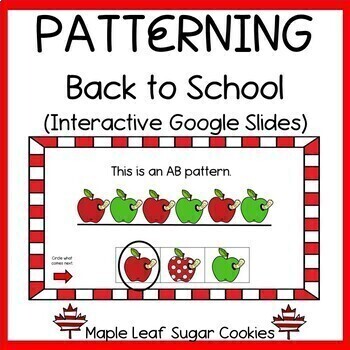Patterning - Back to School * Identify a Pattern * Distance Learning Slides
Maple Leaf Sugar Cookies
407 Followers
Grade Levels
PreK - 3rd
Subjects
Resource Type
Standards
CCSS3.OA.D.9
CCSSMP1
CCSSMP2
Formats Included
- Google Slides™
Pages
15 pages
Maple Leaf Sugar Cookies
407 Followers

Made for Google Drive™
This resource can be used by students on Google Drive or Google Classroom. To access this resource, you’ll need to allow TPT to add it to your Google Drive. See our FAQ and Privacy Policy for more information.
Also included in
- Patterning Google Slides Bundle. Teach about Pattern Types, Pattern Identification, Pattern Core, Attributes and Building a Pattern. Easy for Distance Learning. Includes 4 sets of interactive Google Slides perfect for teaching a range of patterning concepts. Includes a Back to School Version (PatterPrice $5.00Original Price $8.00Save $3.00
Description
***FUN FREEBIE*** Google Slides Patterning Math Center. Students learn and identify pattern types and extend a pattern. Includes simple patterns (AB) and more complex patterns (ABB, ABCD, etc). Easy for Distance Learning. Studetns show what they know by manipulating the slides to select the next object in the pattern. Clip art is culturally appropriate. Excellent for solidifying concepts on an interactive whiteboard in whole class lessons or assessments. Use with devices for a math centre. Can easily be attached to Google Classroom.
Total Pages
15 pages
Answer Key
N/A
Teaching Duration
N/A
Last updated Aug 1st, 2020
Report this resource to TPT
Reported resources will be reviewed by our team. Report this resource to let us know if this resource violates TPT’s content guidelines.
Standards
to see state-specific standards (only available in the US).
CCSS3.OA.D.9
Identify arithmetic patterns (including patterns in the addition table or multiplication table), and explain them using properties of operations. For example, observe that 4 times a number is always even, and explain why 4 times a number can be decomposed into two equal addends.
CCSSMP1
Make sense of problems and persevere in solving them. Mathematically proficient students start by explaining to themselves the meaning of a problem and looking for entry points to its solution. They analyze givens, constraints, relationships, and goals. They make conjectures about the form and meaning of the solution and plan a solution pathway rather than simply jumping into a solution attempt. They consider analogous problems, and try special cases and simpler forms of the original problem in order to gain insight into its solution. They monitor and evaluate their progress and change course if necessary. Older students might, depending on the context of the problem, transform algebraic expressions or change the viewing window on their graphing calculator to get the information they need. Mathematically proficient students can explain correspondences between equations, verbal descriptions, tables, and graphs or draw diagrams of important features and relationships, graph data, and search for regularity or trends. Younger students might rely on using concrete objects or pictures to help conceptualize and solve a problem. Mathematically proficient students check their answers to problems using a different method, and they continually ask themselves, "Does this make sense?" They can understand the approaches of others to solving complex problems and identify correspondences between different approaches.
CCSSMP2
Reason abstractly and quantitatively. Mathematically proficient students make sense of quantities and their relationships in problem situations. They bring two complementary abilities to bear on problems involving quantitative relationships: the ability to decontextualize-to abstract a given situation and represent it symbolically and manipulate the representing symbols as if they have a life of their own, without necessarily attending to their referents-and the ability to contextualize, to pause as needed during the manipulation process in order to probe into the referents for the symbols involved. Quantitative reasoning entails habits of creating a coherent representation of the problem at hand; considering the units involved; attending to the meaning of quantities, not just how to compute them; and knowing and flexibly using different properties of operations and objects.





